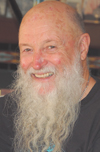Cameo: Cusp of Magic—Terry Riley
SINCE THE 1960s, WHEN HIS GROUNDBREAKING works In C and A Rainbow in Curved Air helped launch what’s come to be known as the minimalist school of composition, Terry Riley has blended advanced technology with improvisation to create music that’s both cutting-edge and deeply human. Drawing on such wide-ranging influences as the electronic compositions of Karlheinz Stockhausen and the Indian master vocalist Pandit Pran Nath, Riley has incorporated synthesizers, tape-looping techniques, and non-Western tunings and temperaments into his works. Riley in turn has worked with and/or influenced fellow composers as diverse in style as Steve Reich, John Adams, Philip Glass, and Pete Townshend.
Riley’s work remains in high demand, from commissions for the Kronos Quartet to live improvisations with artists and musicians worldwide—and Logic Pro 8 plays an integral role in his work as both composer and performer.
In fact, Riley has used Logic since before it was called Logic: When he discovered it around 1990, the program—known then as Notator—was still in its infancy. “It was somewhat of a miracle,” he recalled. “You could play a part on the keyboard and have the notes show up onscreen!”
As Notator migrated to the Mac platform and evolved into Logic Pro, Riley’s use of the program naturally expanded as well. “I still use it a lot for notation, and for the kinds of scores I do, Logic covers everything,” he said. “Once I got into digital audio, I’ve been using that feature a lot.”
Perhaps surprisingly, given his pioneering use of analog tape loops, Riley doesn’t use Logic for digital looping but usually “as a solo instrument.”
“I’ve begun lately to try to use it [Logic Pro 8] for live performance—audio and software instruments.”
For instance, when performing his new piece A Rainbow in Curved Air Revisited—a return to the influential 1968 composition that gave art rockers Curved Air their name and inspired the synthesizer work (and title) of The Who’s “Baba O’Riley”—Riley uses Logic’s software instruments for improvisational passages.
Riley has also made considerable use of Logic for sampling, as when he was developing Cusp of Magic, commissioned by the Kronos Quartet in celebration of Riley’s 70th birthday in 2005. The acclaimed piece includes a vocal section, parts for the pipa (a Chinese lute), and sounds sampled from Kronos leader David Harrington’s extensive collection of toys, as well as a number of snippets of spoken word and voice.
“There was notation with audio—it [Cusp of Magic] had a lot of audio samples, toy sounds, vocal audio samples,” Riley said. Logic was essential to organizing the digital audio elements into a background track that would be played during live performances. “It was so great to lay it out with the notation [in Logic] and get everything precise.”
More recently, Riley used Logic to compose Fairy Tale, a piece for choir, brass, and percussion. Performances of the work will also feature a storyteller onstage—a wrinkle that once again made Logic indispensable. “It was wonderful,” Riley said. “It’ll be performed with a live narrator, but I could lay it out in Logic with my own narration as a temp track.”
For Riley, a major advantage of composing with Logic is its built-in support for just intonation and other custom tunings, which allow a greater range of compositional freedom than the “standard” equal temperament used in Western music.
“Tuning is one of the most important parameters to work with in composing,” he said. “If you use historical temperaments or just intonation, you have a lot more colors available and have to find a way to put them together. They have resonant qualities that aren’t possible in equal temperament.”
Limiting compositions to Western tuning would be like being “a painter with just three colors,” Riley said, adding that he’d encourage anyone who composes with Logic to experiment with alternative tunings. (To do so, choose File > Project Settings > Tuning, and then click the Fixed button. You’ll see a menu that allows you to pick from dozens of historical tunings.)
Summing up what he likes best about using Logic Pro, Riley said he appreciates its integration. “The great thing about Logic is that all the different parts of the program are on the same screen,” he said. “Using the sequencer or doing a piece using software instruments, I can see and change anything when I want to. You can grab any part at any time. It’s a valuable aid to composing.”

